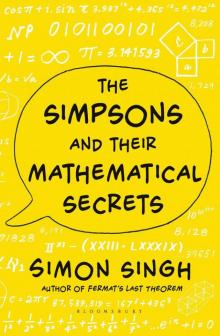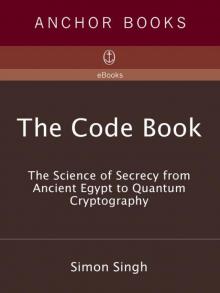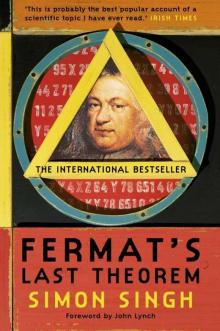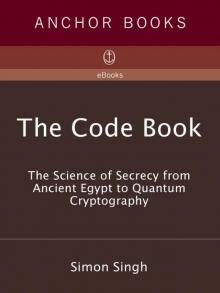- Home
- Simon Singh
The Code Book Page 20
The Code Book Read online
Page 20
After approving Fleming’s plan, known as Operation Ruthless, British Intelligence began preparing a Heinkel bomber for the crash landing, and assembled an aircrew of German-speaking Englishmen. The plan was scheduled for a date early in the month, so as to capture a fresh codebook. Fleming went to Dover to oversee the operation, but unfortunately there was no German shipping in the area so the plan was postponed indefinitely. Four days later, Frank Birch, who headed the Naval section at Bletchley, recorded the reaction of Turing and his colleague Peter Twinn: “Turing and Twinn came to me like undertakers cheated of a nice corpse two days ago, all in a stew about the cancelation of Operation Ruthless.”
In due course Operation Ruthless was canceled, but German Naval codebooks were eventually captured during a spate of daring raids on weather ships and U-boats. These so-called “pinches” gave Bletchley the documents it needed to bring an end to the intelligence blackout. With the Naval Enigma transparent, Bletchley could pinpoint the location of U-boats, and the Battle of the Atlantic began to swing in favor of the Allies. Convoys could be steered clear of U-boats, and British destroyers could even begin to go on the offensive, seeking out and sinking U-boats.
It was vital that the German High Command never suspected that the Allies had pinched Enigma codebooks. If the Germans found that their security had been compromised, they would upgrade their Enigma machines, and Bletchley would be back to square one. As with the Zimmermann telegram episode, the British took various precautions to avoid arousing suspicion, such as sinking a German vessel after pinching its codebooks. This would persuade Admiral Dönitz that the cipher material had found its way to the bottom of the sea, and not fallen into British hands.
Once material had been secretly captured, further precautions had to be taken before exploiting the resulting intelligence. For example, the Enigma decipherments gave the locations of numerous U-boats, but it would have been unwise to have attacked every single one of them, because a sudden unexplained increase in British success would warn Germany that its communications were being deciphered. Consequently, the Allies would allow some U-boats to escape, and would attack others only when a spotter plane had been sent out first, thus justifying the approach of a destroyer some hours later. Alternatively, the Allies might send fake messages describing sightings of U-boats, which likewise provided sufficient explanation for the ensuing attack.
Despite this policy of minimizing telltale signs that Enigma had been broken, British actions did sometimes raise concerns among Germany’s security experts. On one occasion, Bletchley deciphered an Enigma message giving the exact location of a group of German tankers and supply ships, nine in total. The Admiralty decided not to sink all of the ships in case a clean sweep of targets aroused German suspicions. Instead, they informed destroyers of the exact location of just seven of the ships, which should have allowed the Gedania and the Gonzenheim to escape unharmed. The seven targeted ships were indeed sunk, but Royal Navy destroyers accidentally encountered the two ships that were supposed to be spared, and also sank them. The destroyers did not know about Enigma or the policy of not arousing suspicion—they merely believed they were doing their duty. Back in Berlin, Admiral Kurt Fricke instigated an investigation into this and other similar attacks, exploring the possibility that the British had broken Enigma. The report concluded that the numerous losses were either the result of natural misfortune, or caused by a British spy who had infiltrated the Kriegsmarine. The breaking of Enigma was considered impossible and inconceivable.
The Anonymous Cryptanalysts
As well as breaking the German Enigma cipher, Bletchley Park also succeeded in deciphering Italian and Japanese messages. The intelligence that emerged from these three sources was given the codename Ultra, and the Ultra Intelligence files were responsible for giving the Allies a clear advantage in all the major arenas of conflict. In North Africa, Ultra helped to destroy German supply lines and informed the Allies of the status of General Rommel’s forces, enabling the Eighth Army to fight back against the German advances. Ultra also warned of the German invasion of Greece, which allowed British troops to retreat without heavy losses. In fact, Ultra provided accurate reports on the enemy’s situation throughout the entire Mediterranean. This information was particularly valuable when the Allies landed in Italy and Sicily in 1943.
In 1944, Ultra played a major role in the Allied invasion of Europe. For example, in the months prior to D-Day, the Bletchley decipherments provided a detailed picture of the German troop concentrations along the French coast. Sir Harry Hinsley, official historian of British Intelligence during the war, wrote:
As Ultra accumulated, it administered some unpleasant shocks. In particular, it revealed in the second half of May—following earlier disturbing indications that the Germans were concluding that the area between Le Havre and Cherbourg was a likely, and perhaps even the main, invasion area-that they were sending reinforcements to Normandy and the Cherbourg peninsula. But this evidence arrived in time to enable the Allies to modify the plans for the landings on and behind the Utah beach; and it is a singular fact that before the expedition sailed the Allied estimate of the number, identification, and location of the enemy’s divisions in the west, fifty-eight in all, was accurate in all but two items that were to be of operational importance.
Throughout the war, the Bletchley codebreakers knew that their decipherments were vital, and Churchill’s visit to Bletchley had reinforced this point. But the cryptanalysts were never given any operational details or told how their decipherments were being used. For example, the codebreakers were given no information about the date for D-Day, and they arranged a dance for the evening before the landings. This worried Commander Travis, the Director of Bletchley and the only person on site who was privy to the plans for D-Day. He could not tell the Hut 6 Dance Committee to cancel the event because this would have been a clear hint that a major offensive was in the offing, and as such a breach of security. The dance was allowed to go ahead. As it happened, bad weather postponed the landings for twenty-four hours, so the codebreakers had time to recover from the frivolities. On the day of the landings, the French resistance destroyed landlines, forcing the Germans to communicate solely by radio, which in turn gave Bletchley the opportunity to intercept and decipher even more messages. At the turning point of the war, Bletchley was able to provide an even more detailed picture of German military operations.
Stuart Milner-Barry, one of the Hut 6 cryptanalysts, wrote: “I do not imagine that any war since classical times, if ever, has been fought in which one side read consistently the main military and naval intelligence of the other.” An American report came to a similar conclusion: “Ultra created in senior staffs and at the political summit a state of mind which transformed the taking of decisions. To feel that you know your enemy is a vastly comforting feeling. It grows imperceptibly over time if you regularly and intimately observe his thoughts and ways and habits and actions. Knowledge of this kind makes your own planning less tentative and more assured, less harrowing and more buoyant.”
It has been argued, albeit controversially, that Bletchley Park’s achievements were the decisive factor in the Allied victory. What is certain is that the Bletchley codebreakers significantly shortened the war. This becomes evident by rerunning the Battle of the Atlantic and speculating what might have happened without the benefit of Ultra intelligence. To begin with, more ships and supplies would certainly have been lost to the dominant U-boat fleet, which would have compromised the vital link to America and forced the Allies to divert manpower and resources into the building of new ships. Historians have estimated that this would have delayed Allied plans by several months, which would have meant postponing the D-Day invasion until at least the following year. According to Sir Harry Hinsley, “the war, instead of finishing in 1945, would have ended in 1948 had the Government Code and Cypher School not been able to read the Enigma cyphers and produce the Ultra intelligence.”
During this period of delay, addit
ional lives would have been lost in Europe, and Hitler would have been able to make greater use of his V-weapons, inflicting damage throughout southern England. The historian David Kahn summarizes the impact of breaking Enigma: “It saved lives. Not only Allied and Russian lives but, by shortening the war, German, Italian, and Japanese lives as well. Some people alive after World War II might not have been but for these solutions. That is the debt that the world owes to the codebreakers; that is the crowning human value of their triumphs.”
After the war, Bletchley’s accomplishments remained a closely guarded secret. Having successfully deciphered messages during the war, Britain wanted to continue its intelligence operations, and was reluctant to divulge its capabilities. In fact, Britain had captured thousands of Enigma machines, and distributed them among its former colonies, who believed that the cipher was as secure as it had seemed to the Germans. The British did nothing to disabuse them of this belief, and routinely deciphered their secret communications in the years that followed.
Meanwhile, the Government Code and Cypher School at Bletchley Park was closed and the thousands of men and women who had contributed to the creation of Ultra were disbanded. The bombes were dismantled, and every scrap of paper that related to the wartime decipherments was either locked away or burned. Britain’s codebreaking activities were officially transferred to the newly formed Government Communications Headquarters (GCHQ) in London, which was moved to Cheltenham in 1952. Although some of the cryptanalysts moved to GCHQ, most of them returned to their civilian lives, sworn to secrecy, unable to reveal their pivotal role in the Allied war effort. While those who had fought conventional battles could talk of their heroic achievements, those who had fought intellectual battles of no less significance had to endure the embarrassment of having to evade questions about their wartime activities. Gordon Welchman recounted how one of the young cryptanalysts working with him in Hut 6 had received a scathing letter from his old headmaster, accusing him of being a disgrace to his school for not being at the front. Derek Taunt, who also worked in Hut 6, summed up the true contribution of his colleagues: “Our happy band may not have been with King Harry on St. Crispin’s Day, but we had certainly not been abed and have no reason to think ourselves accurs’t for having been where we were.”
After three decades of silence, the secrecy over Bletchley Park eventually came to an end in the early 1970s. Captain F.W. Winterbotham, who had been responsible for distributing the Ultra intelligence, began to badger the British Government, arguing that the Commonwealth countries had stopped using the Enigma cipher and that there was now nothing to be gained by concealing the fact that Britain had broken it. The intelligence services reluctantly agreed, and permitted him to write a book about the work done at Bletchley Park. Published in the summer of 1974, Winterbotham’s book The Ultra Secret was the signal that Bletchley personnel were at last free to discuss their wartime activities. Gordon Welchman felt enormous relief: “After the war I still avoided discussions of wartime events for fear that I might reveal information obtained from Ultra rather than from some published account … I felt that this turn of events released me from my wartime pledge of secrecy.”
Those who had contributed so much to the war effort could now receive the recognition they deserved. Possibly the most remarkable consequence of Winterbotham’s revelations was that Rejewski realized the staggering consequences of his prewar breakthroughs against Enigma. After the invasion of Poland, Rejewski had escaped to France, and when France was overrun he fled to Britain. It would seem natural that he should have become part of the British Enigma effort, but instead he was relegated to tackling menial ciphers at a minor intelligence unit in Boxmoor, near Hemel Hempstead. It is not clear why such a brilliant mind was excluded from Bletchley Park, but as a result he was completely unaware of the activities of the Government Code and Cypher School. Until the publication of Winterbotham’s book, Rejewski had no idea that his ideas had provided the foundation for the routine decipherment of Enigma throughout the war.
For some, the publication of Winterbotham’s book came too late. Many years after the death of Alastair Denniston, Bletchley’s first director, his daughter received a letter from one of his colleagues: “Your father was a great man in whose debt all English-speaking people will remain for a very long time, if not forever. That so few should know exactly what he did is the sad part.”
Alan Turing was another cryptanalyst who did not live long enough to receive any public recognition. Instead of being acclaimed a hero, he was persecuted for his homosexuality. In 1952, while reporting a burglary to the police, he naively revealed that he was having a homosexual relationship. The police felt they had no option but to arrest and charge him with “Gross Indecency contrary to Section 11 of the Criminal Law Amendment Act 1885.” The newspapers reported the subsequent trial and conviction, and Turing was publicly humiliated.
Turing’s secret had been exposed, and his sexuality was now public knowledge. The British Government withdrew his security clearance. He was forbidden to work on research projects relating to the development of the computer. He was forced to consult a psychiatrist and had to undergo hormone treatment, which made him impotent and obese. Over the next two years he became severely depressed, and on June 7, 1954, he went to his bedroom, carrying with him a jar of cyanide solution and an apple. Twenty years earlier he had chanted the rhyme of the Wicked Witch: “Dip the apple in the brew, Let the sleeping death seep through.” Now he was ready to obey her incantation. He dipped the apple in the cyanide and took several bites. At the age of just forty-two, one of the true geniuses of cryptanalysis committed suicide.
5 The Language Barrier
While British codebreakers were breaking the German Enigma cipher and altering the course of the war in Europe, American codebreakers were having an equally important influence on events in the Pacific arena by cracking the Japanese machine cipher known as Purple. For example, in June 1942 the Americans deciphered a message outlining a Japanese plan to draw U.S. Naval forces to the Aleutian Islands by faking an attack, which would allow the Japanese Navy to take their real objective, Midway Island. Although American ships played along with the plan by leaving Midway, they never strayed far away. When American cryptanalysts intercepted and deciphered the Japanese order to attack Midway, the ships were able to return swiftly and defend the island in one of the most important battles of the entire Pacific war. According to Admiral Chester Nimitz, the American victory at Midway “was essentially a victory of intelligence. In attempting surprise, the Japanese were themselves surprised.”
Almost a year later, American cryptanalysts identified a message that showed the itinerary for a visit to the northern Solomon Islands by Admiral Isoruko Yamamoto, Commander-in-Chief of the Japanese Fleet. Nimitz decided to send fighter aircraft to intercept Yamamoto’s plane and shoot him down. Yamamoto, renowned for being compulsively punctual, approached his destination at exactly 8:00 A.M., just as stated in the intercepted schedule. There to meet him were eighteen American P-38 fighters. They succeeded in killing one of the most influential figures of the Japanese High Command.
Although Purple and Enigma, the Japanese and German ciphers, were eventually broken, they did offer some security when they were initially implemented and provided real challenges for American and British cryptanalysts. In fact, had the cipher machines been used properly—without repeated message keys, without cillies, without restrictions on plugboard settings and scrambler arrangements, and without stereotypical messages which resulted in cribs—it is quite possible that they might never have been broken at all.
The true strength and potential of machine ciphers was demonstrated by the Typex (or Type X) cipher machine used by the British army and air force, and the SIGABA (or M-143-C) cipher machine used by the American military. Both these machines were more complex than the Enigma machine and both were used properly, and therefore they remained unbroken throughout the war. Allied cryptographers were confident that complicated electr
omechanical machine ciphers could guarantee secure communication. However, complicated machine ciphers are not the only way of sending secure messages. Indeed, one of the most secure forms of encryption used in the Second World War was also one of the simplest.
During the Pacific campaign, American commanders began to realize that cipher machines, such as SIGABA, had a fundamental drawback. Although electromechanical encryption offered relatively high levels of security, it was painfully slow. Messages had to be typed into the machine letter by letter, the output had to be noted down letter by letter, and then the completed ciphertext had to be transmitted by the radio operator. The radio operator who received the enciphered message then had to pass it on to a cipher expert, who would carefully select the correct key, and type the ciphertext into a cipher machine, to decipher it letter by letter. The time and space required for this delicate operation is available at headquarters or onboard a ship, but machine encryption was not ideally suited to more hostile and intense environments, such as the islands of the Pacific. One war correspondent described the difficulties of communication during the heat of jungle battle: “When the fighting became confined to a small area, everything had to move on a split-second schedule. There was not time for enciphering and deciphering. At such times, the King’s English became a last resort—the profaner the better.” Unfortunately for the Americans, many Japanese soldiers had attended American colleges and were fluent in English, including the profanities. Valuable information about American strategy and tactics was falling into the hands of the enemy.

 The Simpsons and Their Mathematical Secrets
The Simpsons and Their Mathematical Secrets The Code Book
The Code Book Fermat's Last Theorem
Fermat's Last Theorem The Code Book: The Science of Secrecy from Ancient Egypt to Quantum Cryptography
The Code Book: The Science of Secrecy from Ancient Egypt to Quantum Cryptography